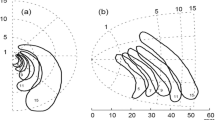Abstract
A debate has been going on for many years about whether migraine with aura and migraine without aura are part of the same disorder or should instead be considered as two separate disorders. Although no final consensus has yet been reached on this issue, many clinical and pathogenetic elements suggest that the second option is true. Clinically, migraine with aura and migraine without aura are differentiated by epidemiological features, the characteristics of the headache phase, patient behaviour during attacks, natural history, age at onset and age at resolution, the recurrence pattern of attacks, favouring circumstances and trigger factors, correlation to female reproductive events, comorbidity and preventive therapies. Moreover, several literature reports suggest a possible different pathogenetic basis for the two forms of migraine.
Similar content being viewed by others
References
Ziegler DK (1985) The headache symptom. How many entities? Arch Neurol 42:273–274
Dalessio DJ (1985) Is there a difference between classic and common migraine? What is migraine after all? Arch Neurol 42:275–276
Hachinski V (1985) Common and classic migraine. One or two entities? Arch Neurol 42:277
Wilkinson M, Blau JN (1985) Are classical and common migraine different entities? Headache 25:211–212
Olesen J (1985) Are classical and common migraine different entities? Headache 25:213
Olesen J, Larsen B, Lauritzen M (1981) Focal hyperemia followed by spreading oligemia and impaired activation of rCBF in classic migraine. Ann Neurol 9:344–352
Olesen J, Tfelt-Hansen P, Henriksen L, Larsen B (1981) The common migraine attack may not be initiated by cerebral ischaemia. Lancet 2:438–440
Stovner LJ, Hagen K, Jensen R et al (2007) The global burden of headache: a documentation of headache prevalence and disability worldwide. Cephalalgia; 27:193–210
Manzoni GC, Stovner LJ (2008) Epidemiology of headache. In: Nappi G, Moskowitz MA (eds) Handbook of clinical neurology, 3rd series. Elsevier, Amsterdam (in press)
Rasmussen BK, Olesen J (1992). Migraine with aura and migraine without aura: an epidemiological study. Cephalalgia 12:221–228
Russell MB, Ulrich V, Gervil M, Olesen J (2002) Migraine without aura and migraine with aura are distinct disorders. A population-based twin survey. Headache 42:332–336
Fisher CM (1986) Late-life migraine accompaniments — further experience. Stroke 17:1033–1042
Nappi G, Manzoni GC (2005) Manuale delle cefalee. Masson, Milan
Manzoni GC, Farina S, Lanfranchi M, Solari A (1985) Classic migraine. Clinical findings in 164 patients. Eur Neurol 24:163–169
Manzoni GC, Farina S, Granella F et al (1986) Classic and common migraine. Suggestive clinical evidence of two separate entities. Funct Neurol 1:112–122
Breslau N, Schultz LR, Stewart WF et al (2000) Headache and major depression: is it the association specific to migraine? Neurology 54:308–313
Breslau N (1998) Psychiatric comorbidity in migraine. Cephalalgia 18[Suppl 22]:56–61
Tzourio C, Iglesias S, Hubert JB et al (1993) Migraine and risk of ischaemic stroke: a case-control study. BMJ 307:289–292
Carolei A, Marini C, De Matteis G (1996) History of migraine and risk of cerebral ischaemia in young adults. Lancet 347:1503–1506
Chang CL, Donaghy M, Poulter N (1999) Migraine and stroke in young women: case-control study. BMJ 318:13–18
Domitrz I, Mieszkowski J, Kamińska A (2007) Relationship between migraine and patent foramen ovale: a study of 121 patients with migraine. Headache 47:1311–1318
Headache Classification Committee of the International Headache Society (1988) Classification and diagnostic criteria for headache disorders, cranial neuralgias and facial pain. Cephalalgia 8[Suppl 7]:1–96
Headache Classification Subcommittee of the International Headache Society (2004) The International Classification of Headache Disorders. 2nd Edition. Cephalalgia 24:1–160
Chronicle EP, Pearson AJ, Mulleners WM (2006) Objective assessment of cortical excitability in migraine with and without aura. Cephalalgia 26:801–808
Author information
Authors and Affiliations
Corresponding author
Rights and permissions
About this article
Cite this article
Manzoni, G.C., Torelli, P. Migraine with and without aura: a single entity?. Neurol Sci 29 (Suppl 1), 40–43 (2008). https://doi.org/10.1007/s10072-008-0884-7
Published:
Issue Date:
DOI: https://doi.org/10.1007/s10072-008-0884-7




